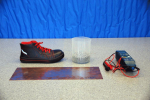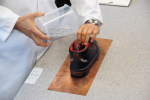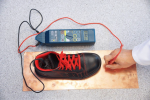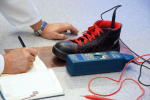Antistatic
 Everyone while working, moving or having contact with other everyday objects is exposed to electric charges. In order to dissipate static electricity that builds up on a user, antistatic clothes and footwear have to be used. Clothes and shoes are intended to remove that charge directly to the ground.
Everyone while working, moving or having contact with other everyday objects is exposed to electric charges. In order to dissipate static electricity that builds up on a user, antistatic clothes and footwear have to be used. Clothes and shoes are intended to remove that charge directly to the ground.
Antistatic boots ensures protection from spark-induced ignition (e.g. flammable substances and vapors) as well as when there is a probable risk of electric shock (in a situation of a damaged electric appliance operated at 250 V). In conditions when the risk of electric shock is not entirely excluded and at the same time, an employee is in an explosive atmosphere, it is necessary to use antistatic boots with electric resistance of more than 100 kΩ and less than or equal to 1000 MΩ.
In DEMAR safety boots antistatic properties are achieved in two ways. The first method is to ensure the antistatic properties of all layers of the bottom part of a boot, i.e.: sole, undersole, lining (the enumerated materials must have charge grounding properties). Thanks to that charges located on a user’s foot are transferred first to the lining, through to the undersole and finally to the sole.
The second solution consists in sewing a special tape with antistatic properties into the shoe lining in the place of the highest contact with the foot. The tape touching the user’s foot carries electric charges away directly to the antistatic sole omitting the lining and the undersole.
In the above-mentioned technologies, it is very important that socks as well as other items of a user’s clothing have antistatic properties.
An electric resistance test (of antistatic properties) involves steel balls being poured into boots, filling them to the brim and ensuring an evenly distributed flow of electric charges. Next the boot is placed on a rectangular piece of copper sheet which will serve as a receiver of electric charges from the shoe. The next stage consists in connecting resistance meter wires to the sheet and balls in the shoe. The meter supplies current of 100 V to the boot, which is followed by measuring the resistance of the current flowing through the boot. If the value of resistance is between 100kΩ and 1000MΩ, boots are considered antistatic.
 |
 |
 |
 |

